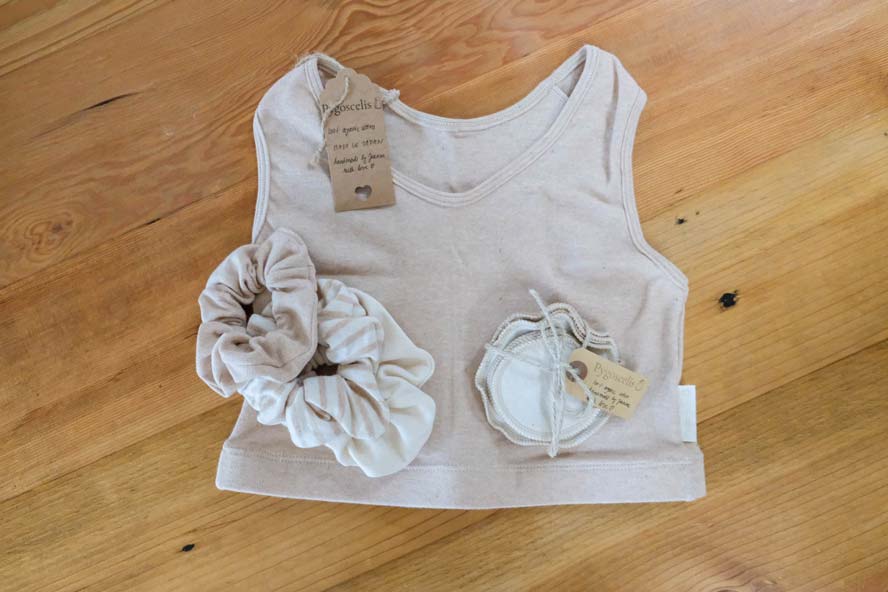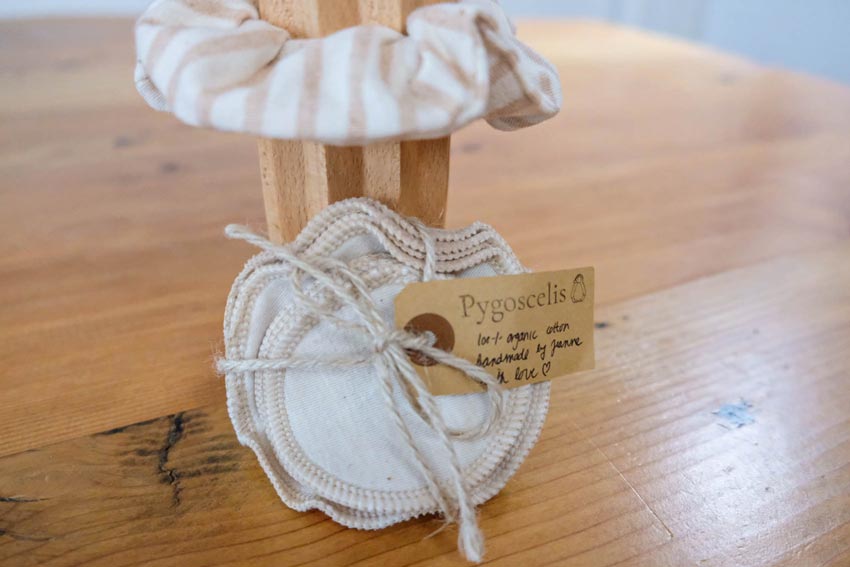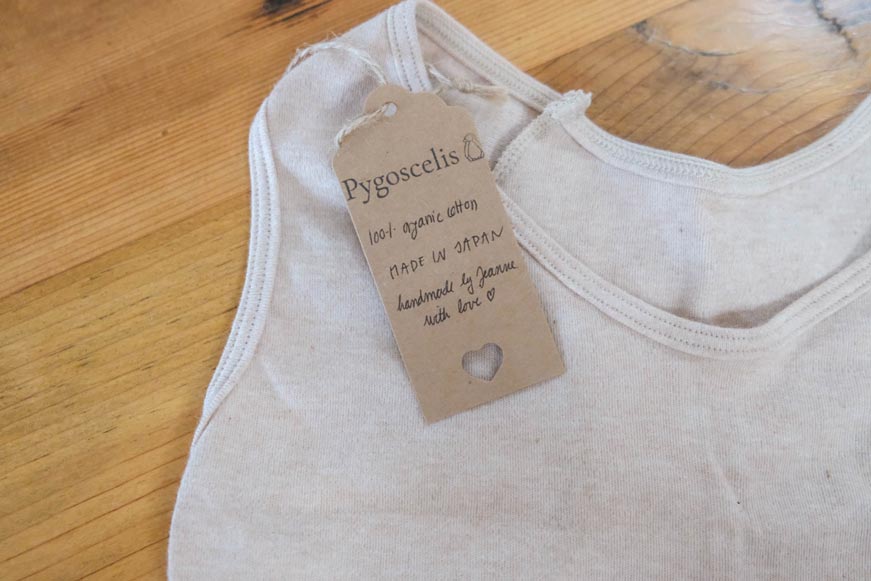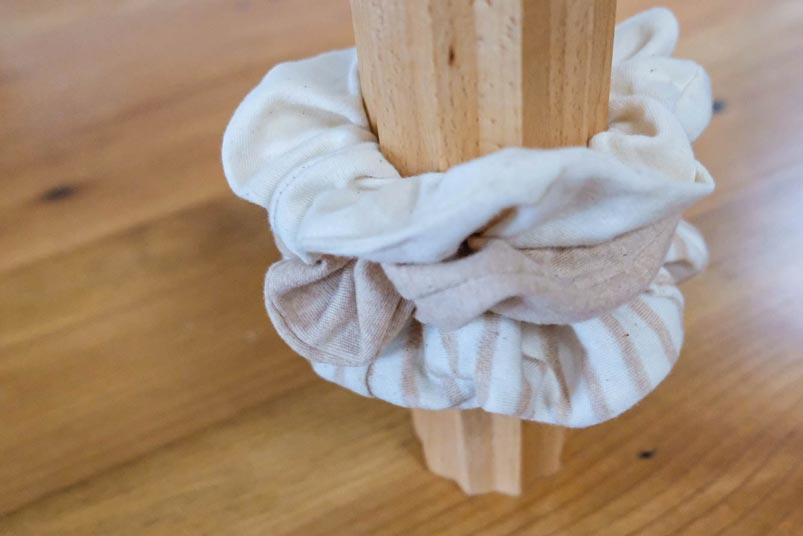
We found Pygoscelis while searching scouring the internet for minimal but functional, sleek and sustainable underwear. It took more effort than it should, but we found a few brands we are way into. One of them is by Jeanne Ebendinger, founder of Pygoscelis.
She hand makes each naturally-dyed item, uses of her excess fabric and has learned a lot along the way. Hear what she has to say about why she chose underwear, perceptions she had that were all wrong and where she’s headed next on her sustainability journey.
Q: How did you come up with the name?
Jeanne Ebendinger: I’m a big fan of penguins and I wanted to incorporate that cute animal into my brand. Pygoscelis is the genus of Adelie Penguin. Explains why the logo is a penguin too 🙂
Q: Who is Pygoscelis for?
Jeanne Ebendinger: Any person who wants ethical/natural/sustainable underwear and wants to wear soft and comfy undies. Pygoscelis is also for people who want to encourage woman-owned business.
Q: When did you launch Pygoscelis?
Jeanne Ebendinger: On November 1st 2018. It’s been almost a year!
Q: What inspired you to launch?
Jeanne Ebendinger: I did my degree in Japan at Waseda University. A bit before graduating I began to wonder how I could have a positive impact on the planet and society while learning new things. For me, the answer was a hand-made underwear brand with local materials. I was inspired to live a more sustainable lifestyle and share my journey with others.
Q: Why underwear?
Jeanne Ebendinger: When it comes to clothes I’d rather encourage people to buy second-hand rather than buying new products. However it might be a bit hard and unhygienic to buy second-hand undies so I wanted to give the opportunity to customers to buy ethical undies made with love!
Also when I first started Pygoscelis I was living in Japan where the “green-lifestyle” is still a bit behind compared to other countries. My original goal with Pygoscelis was to raise awareness about sustainability in Japan, but also all around the world. My undies are a mean not a goal.
Q: I get that about second-hand underwear–especially bottoms. So what ways is Pygoscelis sustainable?
Jeanne Ebendinger: Pygoscelis uses 100% organic cotton (JOCA certified), local materials as much as possible (elastics, threads etc…). All packagings are plastics-free and minimalist. Ethical labor. And with every purchase, money is sent to tree-planting organizations.

Q: And you also make scrunchies and reusable face pads with your leftover fabric–into the low waste mentality. So you never used a sewing machine before launching a hand-sewn underwear brand. What was that like?
Jeanne Ebendinger: It was tremendous work to learn to sew, especially with three different types of machines. Luckily my mother is a talented seamstress, she taught me a lot when I visited her in France. Funny enough, learning to sew wasn’t my main fear – I told myself I’d be able to do it with training. As long as you understand that failing is part of the process you can achieve anything.
It was really important for me to hand make each item because I wanted to offer a product I made with love and could use to spread awareness.

Q: So what were your biggest fears?
Jeanne Ebendinger: My biggest fear was that people wouldn’t be interested in my products. That I wouldn’t be able to sell anything or spread my message. And at first I didn’t sell many products. But I changed my marketing strategy and that led to growth. My family and friends help me remain confident and motivated through this process, and my boyfriend suggested I set a goal of products to sell by the end of August and focus on reaching it. I actually surpassed it by 40! I believe that keeping your goal in mind is the most important.
Q: Based on your experience, what advice would you give someone that also wants to start a brand?
My advice would be to be aware that failure is part of the process. There will be failures and mistakes for sure but it’s essential to get the best out of it and stay positive. Also do a lot of research on the internet about the existing products, markets, business-plan etc… knowledge is power!
Q: What’s the vibe of Pygoscelis and how do you achieve it?
Jeanne Ebendinger: When creating Pygoscelis I wanted people to feel that it is a natural brand made of local materials. I also wanted to close the gap between myself, the founder and my customers. I’m transparent with my work and believe it’s essential for the brand to be honest and share the creation process. I’d aim to achieve our “natural, honest, handmade, simple” vibe through Instagram where I post about my creation process, from sewing to struggling to asking my followers for their thoughts on upcoming products.
Q: What drives your cut, color and fit decisions?
Jeanne Ebendinger: Before starting Pygoscelis it was really hard for me to find a comfy bralette that fits my breast, everything was designed for small breast and it never looked good or felt good. My first product was the top, I wanted to offer a nice support while being cute. Then I wanted to create bottoms that embraced the hip well and doesn’t need to be adjusted every two seconds because it gets stuck in your “valley”. When it comes to color I work with undyed natural fabrics.

Q: What was the process like sourcing all of your materials in Japan?
Jeanne Ebendinger: It was really hard to work with Japanese companies as a foreigner. Not only is it hard to start a business, but doing it in another country is even more difficult. Some people did not want to work with foreigners and others did not want to work with startups. With perseverance, motivation and language assistance from my boyfriend Daiki, I was able to find all the materials I needed in 2 months.
Q: Why is it important for you to use local Japanese-made materials?
Jeanne Ebendinger: Although the raw cotton comes from New Mexico all the woven process is made in Japan. I couldn’t find 100% made Japanese-made fabric so this was my compromise. Using local products is environment-friendly, decreases my carbon footprint and enables me to support local businesses.
Q: From launch until today. What perceptions did you have that proved otherwise?
Jeanne Ebendinger: Main perception was that Japanese people would react well to Pygoscelis but it turns out they don’t. Even though the majority of Japanese I encountered said it was a great initiative they didn’t buy. As soon as I changed my website to USD (previously yen) and started marketing it internationally Pygoscelis grew way faster.
Second perception was that it wouldn’t grow as fast as it did. I didn’t expect people from overseas to buy and send me such supportive messages. More than 90% of my orders come from abroad.

Q: What’s the next step in your sustainability journey?
Jeanne Ebendinger: Next step will be Australia! My boyfriend and I are moving there. In Australia I’ll explore more sustainable fabric than cotton (like lyocell etc…). After Australia we’ll migrate to the UK where I’ll get a masters in sustainability and environmental management.
Q: Where can we buy your stuff?
Jeanne Ebendinger: You can buy on my website.
Q: Thank you so much for your time and sharing you story with us. Is there anything else you want to share or say?
Jeanne Ebendinger: Thank you for giving me the opportunity to share my story! I hope readers will enjoy this article and will be interested in my products but also in sustainable lifestyle. Don’t forget baby steps lead to big steps! Merci.
Drop your email below to request an invite to our community. Members get special interview updates, event invites and giveaways.